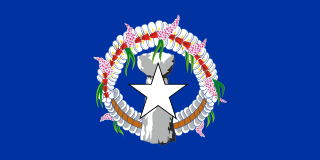
The Northern Mariana Islands, officially the Commonwealth of the Northern Mariana Islands, is an unincorporated territory and commonwealth of the United States consisting of 14 islands in the northwestern Pacific Ocean. The CNMI includes the 14 northernmost islands in the Mariana Archipelago; the southernmost island, Guam, is a separate U.S. territory. The Northern Mariana Islands were listed by the United Nations as a non-self governing territory until 1990.

Typhoon Pongsona was the last typhoon of the 2002 Pacific typhoon season, and was the second costliest United States disaster in 2002, only behind Hurricane Lili. The name "Pongsona" was contributed by North Korea for the Pacific tropical cyclone list and is the Korean name for the garden balsam. Pongsona developed out of an area of disturbed weather on December 2, and steadily intensified to reach typhoon status on December 5. On December 8 it passed through Guam and the Northern Mariana Islands while at peak intensity, with 10-minute sustained winds of 175 km/h (110 mph). It ultimately turned to the northeast, weakened, and became extratropical on December 11.

Asuncion is an island in the Northern Mariana Islands chain in the Pacific Ocean. The island is uninhabited. Asuncion is situated 101 kilometers (63 mi) northwest of Agrihan and 37 km (23 mi) southeast of the Maug Islands.

Alamagan is an island in the Northern Mariana Islands in the Pacific Ocean, 30 kilometres (16 nmi) north of Guguan, 250 kilometres (135 nmi) north of Saipan, and 60 kilometres (32 nmi) south of Pagan. It is currently undergoing resettlement since 2018, with a few people living there. The project was coordinated by the Northern Islands Mayor's office and the people there have radio contact with the mainland.
Francis Raymond Fosberg was an American botanist. A prolific collector and author, he played a significant role in the development of coral reef and island studies.
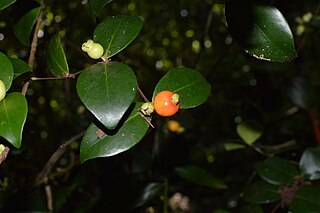
Eugenia palumbis is a shrub with edible fruits in the family Myrtaceae. It is endemic to the Mariana Islands, including Guam and the Commonwealth of the Northern Mariana Islands.
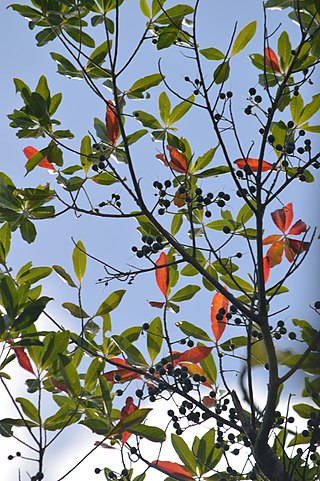
Elaeocarpus joga is a species of tree in the family Elaeocarpaceae. It is native to the Mariana Islands and Palau. It is a moderately-sized tree with blue-coloured, round, 1.5cm diameter fruit and leaves which turn bright red before they senescence.
Callicarpa candicans is a species of flowering plant in the mint family. It is native Indochina, southern China, Malesia, New Guinea, northern Australia, and Micronesia.
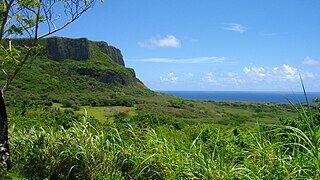
The Marianas tropical dry forests is a tropical and subtropical dry broadleaf forests ecoregion on the Marianas Islands in the western Pacific Ocean.

Varanus tsukamotoi, the Mariana monitor or Saipan monitor, is a species of lizard of the Varanidae family. It is endemic to the Northern Mariana Islands and Guam, and has been introduced to Japtan in the Marshall Islands.

Syzygium thompsonii is an endemic tree of the Mariana Islands of Guam, Rota, and Saipan with a striking appearance due to its abundance of white flowers and edible fruit that grow directly from the trunk. It is related to the Malay apple but bears smaller tart fruit.

Piper salicinum is a plant in the Piperaceae family that is possibly endemic to the Mariana Islands (Guam), although there is some confusion in the literature as to whether it may have been collected from Mexico and Panama. It has not been observed since its initial collection in 1792.
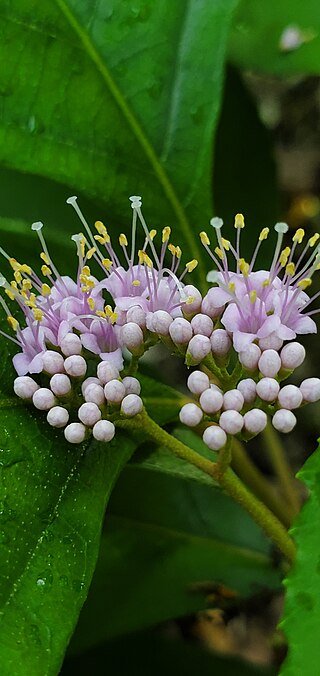
Callicarpa lamii is a plant in the mint family that is endemic to the Mariana Islands. It is one of two Callicarpa plants endemic to the Mariana Islands, the other being Callicarpa candicans var. paucinervia.

Rhaphidophora guamensis is a climbing plant in the family Araceae that is endemic to the island of Guam in the Mariana Islands.
Psychotria hombroniana is shrub or tree in the family Rubiaceae that is endemic to the Caroline and Mariana Islands in the northwest Pacific Ocean.

Terminalia rostrata is a large tree found only on the Mariana Island of Asuncion. It is a part of the "Terminalia and ravine forest" on the western and southwestern slopes of the island, consisting of scattered Terminalia rostrata in association with Premna serratifolia, Morinda citrifolia,Hibiscus tiliaceus, and Pandanus tectorius. This forest type is described as the best-developed forest in the Mariana Islands north of Saipan, owing to its protection on the lee side of the mountain. The leaves of Terminalia rostrata are most similar to Terminalia catappa, but they have soft hairs similar to that of Terminalia samoensis. It is otherwise most similar to Terminalia foetidissima, although differing in various ways. The species name refers to the strongly beaked fruit. Fruit bats feed on the husks of the seeds. The species was first discovered by Marjorie V. C. Falanruw during an expedition to the far northern Mariana islands in 1972 and was first described by Francis Raymond Fosberg in the journal Phytologia in 1974.

The Micronesian rufous fantail is a species of bird in the family Rhipiduridae that is endemic to the Mariana Islands and the island of Yap in Micronesia. It was formerly considered to be a subspecies of the Australian rufous fantail.
Aidia racemosa is a tree in the Rubiaceae family, native from Thailand east to the Pacific islands and south to Australia.

Leptecophylla mariannensis is a plant in the Ericaceae family and is only known to exist on the tiny island of Alamagan in the Mariana archipelago.















